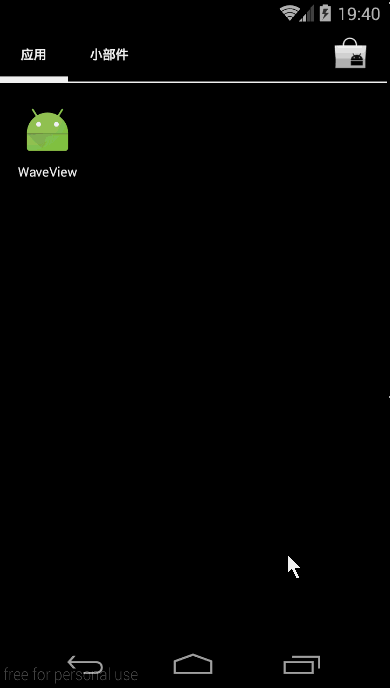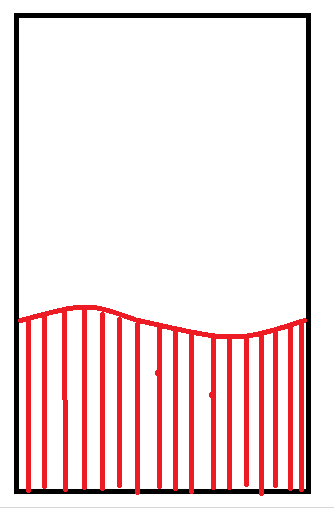效果:

是不是觉得有新意多了呢?那就一起来看看吧,先简单讲述一下思路:首先波浪的形状主要是根据三角函数决定的。三角函数相信大家在中学的课程中学习过吧。通用公式就是f(x)=Asin(ωx+φ) + b。其中A就是波浪的振幅,ω与时间周期有关,x就是屏幕宽度的像素点,φ是初相,可以让波浪产生偏移,最后的b就是水位的高度了。最后根据这公式算出y坐标,用canvas.drawLine(startX, startY, stopX, stopY, paint);来画出竖直的线条,这样就形成了波浪。
整体的思路就如下面示意图所示,当红色的线条间距越来越小,密度越来越大时就形成了波浪:

讲完了思路,那下面我们就来分析一下代码吧。
首先看一下“自定义View三部曲”中的第一部,自定义属性:
1
2
3
4
5
6
7
8
9
10
| <?xml version="1.0" encoding="utf-8"?>
<resources>
<declare-styleable name="WaveView">
<attr name="waveColor" format="color|reference"></attr>
<attr name="secondWaveColor" format="color|reference"></attr>
<attr name="waveHeight" format="dimension|reference"></attr>
</declare-styleable>
</resources>
|
我们先定义了三个属性,分别是前波浪颜色、后波浪颜色以及波浪的振幅高度。
然后就是在构造器中初始化自定义的属性。
1
2
3
4
5
6
7
8
9
10
11
12
13
14
15
16
17
18
19
20
| public WaveView(Context context) {
this(context, null);
}
public WaveView(Context context, AttributeSet attrs) {
this(context, attrs, 0);
}
public WaveView(Context context, AttributeSet attrs, int defStyleAttr) {
super(context, attrs, defStyleAttr);
TypedArray a = getContext().obtainStyledAttributes(attrs, R.styleable.WaveView);
defaultWaveColor = getResources().getColor(R.color.indigo_color);
waveColor = a.getColor(R.styleable.WaveView_waveColor, defaultWaveColor);
defaultSecondWaveColor = getResources().getColor(R.color.second_indigo_color);
secondWaveColor = a.getColor(R.styleable.WaveView_secondWaveColor, defaultSecondWaveColor);
defaultWaveHeight = TypedValue.applyDimension(TypedValue.COMPLEX_UNIT_DIP, 10, getResources().getDisplayMetrics());
waveHeight = a.getDimension(R.styleable.WaveView_waveHeight, defaultWaveHeight);
a.recycle();
mPaint = new Paint(Paint.ANTI_ALIAS_FLAG);
}
|
前面的代码很简单,接下来要重写onSizeChanged(int w, int h, int oldw, int oldh):
1
2
3
4
5
| @Override
protected void onSizeChanged(int w, int h, int oldw, int oldh) {
super.onSizeChanged(w, h, oldw, oldh);
this.w = (float) (Math.PI * 2 / w);
}
|
这里的w就是上面f(x)=Asin(ωx+φ) + b公式中的ω,而ω=2π/T。也就是说周期就是屏幕宽度。所以在一个屏幕内正好可以显示出正弦函数的一个周期。
下面就是三部曲的第二部:重写onMeasure(int widthMeasureSpec, int heightMeasureSpec):
1
2
3
4
5
6
7
8
9
10
11
12
13
14
15
16
17
18
19
20
| @Override
protected void onMeasure(int widthMeasureSpec, int heightMeasureSpec) {
super.onMeasure(widthMeasureSpec, heightMeasureSpec);
int widthSize = MeasureSpec.getSize(widthMeasureSpec);
int widthMode = MeasureSpec.getMode(widthMeasureSpec);
if (widthMode == MeasureSpec.EXACTLY) {
mWidth = widthSize;
} else {
mWidth = 200;
}
int heightSize = MeasureSpec.getSize(heightMeasureSpec);
int heightMode = MeasureSpec.getMode(heightMeasureSpec);
if (heightMode == MeasureSpec.EXACTLY) {
mHeight = heightSize;
} else {
mHeight = 200;
}
setMeasuredDimension(mWidth, mHeight);
}
|
onMeasure()中就是测量了View的宽高度,如果不是MeasureSpec.EXACTLY的模式就直接赋值200(这里没有把200px转化为200dp,偷懒了ㄟ(▔ ,▔)ㄏ)。相信大家都会了。
最后就是onDraw(Canvas canvas),也就是三部曲中的最后一部:
1
2
3
4
5
6
7
8
9
10
11
12
13
14
15
16
17
18
19
20
21
22
23
24
25
26
27
28
29
30
31
32
33
34
35
36
37
38
39
| @Override
protected void onDraw(Canvas canvas) {
waterHeight = waterHeight + 10;
float startY;
canvas.save();
if (System.currentTimeMillis() - startTime < 100) {
try {
Thread.sleep(100 + startTime - System.currentTimeMillis());
} catch (InterruptedException e) {
e.printStackTrace();
}
}
double temp = Math.toDegrees(speed);
speed++;
mPaint.setColor(secondWaveColor);
for (int i = 0; i < mWidth; i++) {
startY = (float) (waveHeight * Math.sin(w * i + temp + 8) + mHeight - waveHeight - waterHeight);
canvas.drawLine(i, startY, i, mHeight, mPaint);
}
mPaint.setColor(waveColor);
for (int i = 0; i < mWidth; i++) {
startY = (float) (waveHeight * Math.sin(w * i + temp) + mHeight - waveHeight - waterHeight);
canvas.drawLine(i, startY, i, mHeight, mPaint);
}
Log.i(TAG, "waterHeight : " + waterHeight);
canvas.restore();
invalidate();
startTime = System.currentTimeMillis();
}
|
在onDraw(Canvas canvas)的一开始waterHeight不断自增,以此来实现水位不断上涨的效果,然后就是线程的休眠来控制绘制的频率。之后在绘制第二条波浪时初相加上一个偏移量,这样就可以与第一条波浪形成交错的效果。整体代码并不复杂,主要是坐标上的计算。

